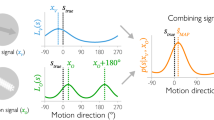Abstract
Humans can accurately perceive the location of a sound source—not only the direction, but also the distance1,2,3,4,5,6,7,8,9. Sounds near the head, within ducking or reaching distance, have a special saliency. However, little is known about this perception of auditory distance. The direction to a sound source can be determined by interaural differences, and the mechanisms of direction perception have been studied intensively1; but except for studies on echolocation in the bat10, little is known about how neurons encode information on auditory distance. Here we describe neurons in the brain of macaque monkeys (Macaca fascicularis) that represent the auditory space surrounding the head, within roughly 30 cm. These neurons, which are located in the ventral premotor cortex, have spatial receptive fields that extend a limited distance outward from the head.
This is a preview of subscription content, access via your institution
Access options
Subscribe to this journal
Receive 51 print issues and online access
$199.00 per year
only $3.90 per issue
Buy this article
- Purchase on Springer Link
- Instant access to full article PDF
Prices may be subject to local taxes which are calculated during checkout


Similar content being viewed by others
References
Blauert, J. Spatial Hearing: The Psychophysics of Human Sound Localization (transl. Allen, J. S.) (MIT Press, Cambridge, Massachusetts, (1997)).
Clifton, R. K., Rochat, P., Robin, D. J. & Berthier, N. E. Multimodal perception in the control of infant reaching. J. Exp. Psychol. Hum. Percept. Perform. 20, 876–886 (1994).
Coleman, P. D. An analysis of cues to auditory depth perception in free space. Psychol. Bull. 60, 302–315 (1963).
Coleman, P. D. Dual role of frequency spectrum in determination of auditory distance. J. Acoust. Soc. Am. 44, 631–632 (1968).
Edwards, A. A. Accuracy of auditory depth perception. J. Gen. Psychol. 52, 327–329 (1955).
Gamble, E. A. Intensity as a criterion in estimating the distance of sounds. Psychol. Rev. 16, 416–426 (1909).
Gardner, M. B. Distance estimation of 0° or apparent 0°-oriented speech signals in anechoic space. J. Acoust. Soc. Am. 45, 47–53 (1969).
Mershon, D. H. & Bowers, J. N. Absolute and relative cues for the auditory perception of egocentric distance. Perception 8, 311–322 (1979).
von Bekesy, G. Experiments in Hearing (McGraw-Hill, New York, (1960)).
Suga, N. & O'Neill, W. E. Neural axis representing target range in the auditory cortex of the mustache bat. Science 206, 351–353 (1979).
Gentilucci, M. et al. Functional organization of inferior area 6 in the macaque monkey. I. Somatotopy and the control of proximal movements. Exp. Brain. Res. 71, 475–490 (1988).
Fogassi, L. et al. Coding of peripersonal space in inferior premotor cortex (area F4). J. Neurophysiol. 76, 141–157 (1996).
Graziano, M. S. A., Yap, G. S. & Gross, C. G. Coding of visual space by pre-motor neurons. Science 266, 1054–1057 (1994).
Graziano, M. S. A., Hu, X. & Gross, C. G. Coding the locations of objects in the dark. Science 277, 239–241 (1997).
Rizzolatti, G. et al. Afferent properties of periarcuate neurons in macaque monkeys. II. Visual responses. Behav. Brain Res. 2, 147–163 (1981).
Graziano, M. S. A., Hu, X. & Gross, C. G. Visuo-spatial properties of ventral premotor cortex. J. Neurophysiol. 77, 2268–2292 (1997).
Ashmead, D. H., LeRoy, D. & Odom, R. D. Perception of the relative distances of nearby sound sources. Percept. Psychophys. 47, 326–331 (1990).
Mershon, D. H. & King, L. E. Intensity and reverberation as factors in the auditory perception of egocentric distance. Percept. Psychophys. 18, 409–415 (1975).
Coleman, P. D. Failure to localize the source distance of an unfamiliar sound. J. Acoust. Soc. Am. 34, 345–346 (1962).
Graziano, M. S. A., Fernandez, T. & Gross, C. G. Acomparison of bimodal, visual-tactile neurons in parietal area 7b and ventral premotor cortex of the monkey brain. Neurosci. Abs. 22, 398 (1996).
Cavada, C. & Goldman-Rakic, P. S. Posterior parietal cortex in rhesus monkey: II: Evidence for segregated corticocortical networks linking sensory and limbic areas with the frontal lobe. J. Comp. Neurol. 287, 422–445 (1989).
Matelli, M., Camarda, R., Glickstein, M. & Rizzolatti, G. Afferent and efferent projections of the inferior area 6 in the macaque monkey. J. Comp. Neurol. 255, 281–298 (1986).
Graziano, M. S. A. & Gross, C. G. Spatial maps for the control of movement. Curr. Opin. Neurobiol. 8, 195–201 (1998).
Rizzolatti, G., Fadiga, L., Fogassi, L. & Gallese, V. The space around us. Science 277, 190–191 (1997).
Boussaoud, D., Barth, T. M. & Wise, S. P. Effects of gaze on apparent visual responses of frontal cortex neurons. Exp. Brain Res. 93, 423–434 (1993).
Cohen, J. & P. Cohen, P. Applied Multiple Regression/Correlation Analysis for the Behavioral Sciences (Lawrence Earlbaum Associates, Hillsdale, New Jersey, (1983)).
Acknowledgements
We thank E. Olson, X. Hu, S. Alisharan, M. E. Wheeler and V. Gomez for their help during the experiment.
Author information
Authors and Affiliations
Corresponding author
Rights and permissions
About this article
Cite this article
Graziano, M., Reiss, L. & Gross, C. A neuronal representation of the location of nearby sounds. Nature 397, 428–430 (1999). https://doi.org/10.1038/17115
Received:
Accepted:
Issue Date:
DOI: https://doi.org/10.1038/17115
This article is cited by
-
Back and front peripersonal space: behavioural and EMG evidence of top–down and bottom–up mechanisms
Experimental Brain Research (2024)
-
Dissociation of perception and motor execution of lower limb in multi-directional movements
Scientific Reports (2023)
-
Shaping the auditory peripersonal space with motor planning in immersive virtual reality
Virtual Reality (2023)
-
Multisensory-driven facilitation within the peripersonal space is modulated by the expectations about stimulus location on the body
Scientific Reports (2022)
-
Peripersonal Space from a multisensory perspective: the distinct effect of the visual and tactile components of Visuo-Tactile stimuli
Experimental Brain Research (2022)
Comments
By submitting a comment you agree to abide by our Terms and Community Guidelines. If you find something abusive or that does not comply with our terms or guidelines please flag it as inappropriate.



